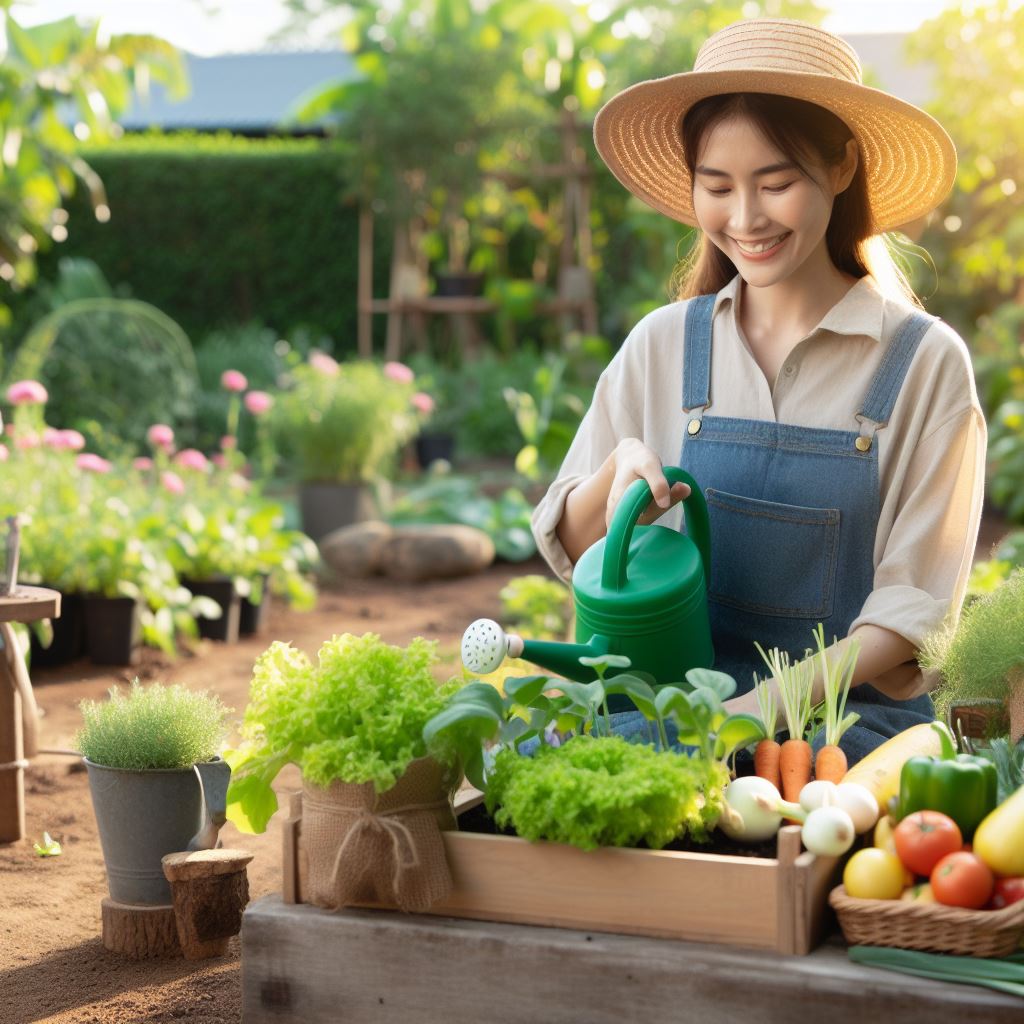Introduction
In this blogpost, we will explore the topic of seasonal planting guide for compact spaces.
Gardening in limited areas can be challenging, but with the right strategies, it can be optimized to its fullest potential.
Importance of optimizing limited space for gardening and the benefits of seasonal planting
Optimizing limited gardening space is crucial for urban dwellers and those with restricted land.
Utilizing vertical gardening, raised beds, and container gardening maximizes yield.
Seasonal planting ensures optimal growth and resource utilization, promoting biodiversity and soil health.
It also offers a variety of fresh produce year-round, reduces food miles, and fosters a deeper connection to the natural rhythms of the environment, enhancing overall well-being.
Seasonal planting brings numerous benefits, such as maximizing yields, reducing pests, and creating a vibrant and ever-changing garden.
Get ready to discover how to make the most out of your compact gardening space.
Understanding Compact Spaces
Defining Compact Spaces for Gardening
A compact space for gardening refers to any small area that can be utilized for planting.
This can include balconies, rooftop gardens, small yard spaces, or even indoor areas.
The Challenges of Gardening in Small Areas
- Limited space poses challenges in terms of plant selection and growth.
- Lack of sufficient soil and sunlight can limit the types of plants that can thrive.
- Managing pest control becomes more difficult in compact spaces.
- Restricted area may also limit the number of plants that can be grown.
The Need for Creative Solutions
- Efficient space utilization is crucial for gardening in compact areas.
- Vertical gardening allows for planting on walls, trellises, or hanging baskets.
- Container gardening can make use of pots, planters, and raised beds to maximize space.
- Utilizing small areas in between larger plants or in compact corners can be helpful.
- Incorporating companion planting can make the most of limited gardening spaces.
- Using reflective materials, such as mirrors, can help maximize sunlight in shaded areas.
- Opting for dwarf or compact varieties of plants can save space without sacrificing productivity.
Maximizing Your Available Space
- Careful planning is essential to make the most of your compact gardening space.
- Start by assessing your available area and measuring the dimensions for accurate planning.
- Consider the sunlight exposure in your space to determine which plants will thrive.
- Opt for plants that are suitable for small spaces and have a high yield.
- Use vertical space for climbing plants like tomatoes, cucumbers, or beans.
- Hanging baskets can be used to grow herbs, strawberries, or trailing flowers.
- Utilize windowsills or narrow strips of soil for smaller herbs, such as mint or parsley.
- Create a focal point in your garden with a vertical, eye-catching structure or a decorative trellis.
- Place smaller plants near the edges to allow for easy access and maximize space.
- Consider using wall-mounted planters or trellises to grow vining or trailing plants.
- Use tiered shelving or staggered plant heights to create depth in your compact garden.
- Implement a watering system that efficiently uses water and reaches all plants.
- Add compost or organic matter to nourish the plants and improve the soil quality.
- Regularly prune and trim plants to maintain their shape and prevent overcrowding.
- Make use of organic pest control methods to minimize damage to your plants.
In essence, gardening in compact spaces requires a strategic approach and creative solutions.
By utilizing vertical gardening, container gardening, and making efficient use of available space, you can create a thriving garden in even the smallest areas.
So, embrace your compact space and let your gardening skills flourish!
Selecting suitable plants for compact spaces
In order to successfully grow plants in a compact space, it is important to carefully choose the right ones.
Here is a list of vegetables, herbs, and flowers that thrive in small areas:
Transform Your Agribusiness
Unlock your farm's potential with expert advice tailored to your needs. Get actionable steps that drive real results.
Get Started- Vegetables: cherry tomatoes, lettuce, radishes, carrots, green beans
- Herbs: basil, parsley, chives, mint, thyme
- Flowers: marigolds, pansies, petunias, nasturtiums, zinnias
Choosing plants that have a compact growth habit or are suitable for container gardening is crucial when dealing with limited space.
This ensures that they won’t overwhelm the area and can be easily maintained.
Key factors to consider when selecting plants
When selecting plants, there are key factors to consider:
Sunlight requirements
Determine how much sun exposure your compact space receives throughout the day.
Some plants require full sun, while others prefer partial shade.
Soil conditions
Assess the quality and composition of your soil. Plants thrive in well-draining soil that is rich in organic matter.
If needed, amend the soil with compost or other organic materials.
Climate suitability
Understand the climate conditions in your area.
Some plants are more suited to hot and dry climates, while others prefer cooler temperatures or humid environments.
By considering these factors, you can select plants that will thrive in your specific compact space.
Here are some tips to help you make the best choices:
- Take note of the location of your compact space – is it shaded by buildings or trees? Are there areas of full sun?
- Research the specific needs of the plants you are interested in. Check their sunlight, soil, and climate requirements to ensure they are compatible with your space.
- Consider the size of the mature plant. Will it outgrow the area or container? Choose plants that are suitable for the available space.
- Look for compact varieties or dwarf cultivars. These are specifically bred to grow smaller, making them ideal for confined areas.
- Opt for plants with vertical growth habits. Vines, climbers, and trellis-trained plants can make efficient use of vertical space.
Remember to provide adequate care and maintenance for your chosen plants.
Regular watering, fertilizing, and pruning will help them flourish in your compact space.
By selecting suitable plants, considering key factors, and providing proper care, you can create a thriving garden in even the smallest of spaces.
Enjoy the beauty and abundance of nature, no matter how compact!
Read: Organic Gardening: Grow More in Less Space
Creating a Seasonal Planting Plan
One of the keys to successful gardening in compact spaces is having a well-thought-out seasonal planting plan.
This guide will explain the concept of a seasonal planting plan and its benefits, outline the different seasons and their corresponding plant varieties, and provide readers with a step-by-step guide on how to plan their planting schedule based on the specific growing seasons in their region.
Explain the concept of a seasonal planting plan and its benefits for compact spaces
A seasonal planting plan is a schedule that outlines what plants to grow during each season of the year.
By following a seasonal planting plan, gardeners can maximize their space and ensure that their plants thrive throughout the year.
This is especially important for compact spaces, where every inch of land needs to be utilized effectively.
Different seasons and their corresponding plant varieties
Each season has its own unique set of plant varieties that thrive during that time. In spring, cool-season crops such as lettuce, spinach, and peas are ideal for compact spaces.
These plants can be grown directly in the ground or in containers.
As summer arrives, warm-season crops like tomatoes, peppers, and cucumbers become the focal point.
Showcase Your Farming Business
Publish your professional farming services profile on our blog for a one-time fee of $200 and reach a dedicated audience of farmers and agribusiness owners.
Publish Your ProfileMany of these plants can be grown vertically, saving space and allowing for more variety.
In the fall, cool-season crops make a comeback, with options such as kale, broccoli, and carrots.
Finally, in winter, compact spaces can be used for growing herbs and greens indoors or in protected areas.
How to plan their planting schedule based on the specific growing seasons in their region
Planning your planting schedule based on the specific growing seasons in your region is crucial.
Start by determining your last frost date and first frost date, as these will serve as reference points for each season.
Consult local gardening resources or extension offices to find out which crops thrive during each season in your area.
Make a list of the plants you want to grow, and group them according to their respective seasons.
This will help you visualize your planting plan.
When creating your planting schedule, consider factors such as the time it takes for each plant to mature, the space required for each variety, and the succession planting technique.
Succession planting involves sowing seeds or planting seedlings at different intervals to ensure a continuous harvest throughout the season.
By staggering your plantings, you can make the most of your compact space and ensure a steady supply of fresh produce.
To make your seasonal planting plan more organized, create a planting calendar or use a gardening app that allows you to schedule your plantings and set reminders for important tasks such as watering, fertilizing, and harvesting.
This will help you stay on track and make adjustments as needed.
In general, a well-planned seasonal planting schedule is essential for maximizing the potential of compact spaces.
By understanding the concept of a seasonal planting plan, knowing which plants thrive during each season, and carefully planning your planting schedule based on your region’s growing seasons, you can create a thriving garden in even the smallest of spaces.
Happy gardening!
Read: DIY Compost Bins: Cheap and Effective Designs
Maximizing Vertical Space
Utilizing vertical gardening techniques in compact spaces is essential for maximizing the available area.
By growing plants vertically, you can create a flourishing garden even in tight spaces.
Here are some tips and ideas to make the most of your vertical gardening:
Trellises
Trellises are great for supporting climbing plants such as tomatoes, cucumbers, and beans.
They provide a structured framework for the plants to grow vertically, saving precious ground space.
Install trellises against walls or fences to maximize vertical growing potential.
Wall-Mounted Planters
Mounting planters on walls is an excellent way to add greenery to compact spaces.
Use wall-mounted planters to grow herbs, lettuces, or even small flowering plants.
These planters can be easily installed and create a stunning vertical display.
Hanging Baskets
Hanging baskets are perfect for trailing plants or flowers.
Hang them from hooks or install a hanging basket stand.
Fill these baskets with colorful flowers like petunias or cascading vines like nasturtiums to create a vibrant vertical garden.
When choosing plants for vertical gardening, consider those that naturally grow in a trailing or vining manner.
Here are some recommendations:
Vine Vegetables
Plants like cucumbers, tomatoes, and peas are excellent choices for vertical gardening.
They have tendrils or are capable of climbing with the help of trellises.
Growing these vegetables vertically saves space and makes harvesting more convenient.
Trailing Flowers
Trailing flowers are perfect for adding a touch of color and elegance to your compact space.
Consider planting trailing petunias, lobelia, or nasturtiums.
These flowers will drape beautifully from hanging baskets or wall-mounted planters.
Climbing Roses
Climbing roses are a stunning addition to any vertical garden.
They can be trained to grow on trellises or lattice structures, adding beauty and fragrance to your compact space.
Choose varieties that are suitable for your climate and enjoy their enchanting blooms.
Showcase Your Farming Business
Publish your professional farming services profile on our blog for a one-time fee of $200 and reach a dedicated audience of farmers and agribusiness owners.
Publish Your ProfileVertical gardening not only maximizes space but also creates a visually appealing garden.
Don’t limit your gardening dreams due to space constraints.
Embrace vertical gardening and watch your compact space transform into a lush and vibrant oasis!
Read: Worm Composting: Turning Waste into Gold

Utilizing containers and raised beds
Advantages of Using Containers and Raised Beds in Compact Spaces
- Containers and raised beds allow gardening in limited space.
- They are ideal for urban dwellers with small yards or balconies.
- Containers and raised beds are portable and can be moved to optimize sunlight exposure.
- They prevent weeds and minimize the spread of diseases and pests.
- Containers and raised beds promote better soil drainage and aeration.
- They provide better control over soil quality and nutrient levels.
- Using containers and raised beds reduces strain on the back and knees.
- These methods allow for easier monitoring and maintenance of plants.
- Containers and raised beds can be designed to match the aesthetic of the surrounding area.
Types of Containers and Raised Beds That Work Well in Small Areas
- Choose containers made of durable material like plastic, ceramic, or wood.
- Opt for containers with adequate drainage holes to prevent waterlogging.
- Consider using hanging baskets or window boxes for vertical gardening.
- Vertical planters and tiered containers are great for maximizing space.
- Choose raised beds made of non-toxic materials like untreated wood or metal.
- Use galvanized steel or composite lumber for longevity.
- Stackable or modular raised bed systems are suitable for compact spaces.
- Consider using trellises and vertical structures to train plants and save space.
Tips for Successful Container and Raised Bed Gardening
- Select a container or raised bed that suits the size and requirements of the plants.
- Use high-quality potting soil with good drainage and moisture-retention properties.
- Water containers and raised beds regularly, as they tend to dry out faster.
- Avoid overwatering by checking the moisture levels before watering.
- Fertilize regularly with organic or slow-release fertilizers to provide essential nutrients.
- Monitor plants for pests and diseases and take prompt action if necessary.
- Prune and train plants to avoid overcrowding and promote healthy growth.
- Rotate crops in raised beds to prevent soil depletion and minimize disease risks.
- Clean containers and raised beds regularly to prevent the buildup of pests or diseases.
- Protect plants from extreme weather conditions by using covers or providing shade.
By utilizing containers and raised beds, individuals with limited space can enjoy the benefits of gardening.
These methods allow for flexibility, better soil control, and improved plant health.
With the right containers and raised beds, along with proper care techniques, a lush garden can thrive even in the smallest of spaces.
Read: Compost Teas: Boosting Plant Health Naturally
Maintenance and Care Tips
Advise readers on how to care for their compact space garden throughout the seasons:
- Monitor the weather conditions and adjust watering and care accordingly.
- Regularly check for signs of pests and diseases to catch them early and prevent damage.
- Keep a calendar or schedule to stay organized with your gardening tasks.
- Provide proper support and staking for plants that tend to become top-heavy.
- Harvest crops regularly to encourage continuous production and prevent overcrowding.
- Rotate crops each season to avoid depleting the soil of certain nutrients.
- Plan ahead and protect your plants from potential threats, such as extreme temperatures or strong winds.
Provide guidelines for watering, fertilizing, and protecting plants from pests and diseases:
- Water plants deeply and thoroughly, allowing the soil to dry out slightly between waterings.
- Avoid overwatering, as it can lead to root rot and other fungal diseases.
- Apply organic or slow-release fertilizers according to package instructions to provide essential nutrients.
- Avoid over-fertilizing, which can harm the plants and create imbalances in the soil.
- Regularly inspect plants for signs of pests, such as holes in leaves or sticky residue, and take appropriate measures, such as using organic pesticides or introducing beneficial insects.
- Keep the garden area clean and free from debris to minimize hiding places for pests and diseases.
- Follow recommended spacing guidelines to ensure proper air circulation and reduce the risk of diseases.
Suggest regular maintenance tasks, such as pruning, harvesting, and replanting:
- Prune plants to remove dead or diseased branches, improve airflow, and maintain their shape.
- Harvest crops when they are at their peak ripeness to enjoy the best flavor and quality.
- Replant empty spaces with new crops or flowers to maximize productivity and aesthetics.
- Regularly deadhead flowers to encourage continuous blooming and prevent seed production.
- Remove weeds regularly to avoid competition for nutrients and space.
- Monitor the growth of plants and thin out overcrowded areas to ensure proper development.
- Control invasive plants that can take over your compact space garden and cause harm to other plants.
By following these maintenance and care tips, you can ensure a thriving and productive compact space garden throughout the seasons.
Remember to assess and adjust your care routine based on the specific needs of your plants and the changing weather conditions.
Happy gardening!
Conclusion
The main points discussed in the blog post
In closing, this blog post highlighted the importance of seasonal planting in compact spaces.
We discussed the benefits of utilizing limited areas for gardening and provided a comprehensive guide on how to do so.
By following the tips and techniques shared in this post, readers can create their own thriving compact space gardens.
Seasonal planting offers numerous advantages, such as maximizing yields, utilizing space efficiently, and enjoying fresh and flavorful produce.
Additionally, gardening in limited areas promotes sustainability and encourages a deeper connection with nature.
Encouragement to start their own compact space gardens and highlight the benefits of seasonal planting.
We hope that this blog post has inspired readers to start their own compact space gardens.
No matter how small, any space can be transformed into a green oasis.
Gardening in limited areas allows individuals to tap into their creativity and make the most of the resources available to them.
Remember, even the tiniest of spaces hold immense potential for growth and beauty.
So, go ahead and embark on this rewarding journey of gardening in limited areas.
Happy planting!




